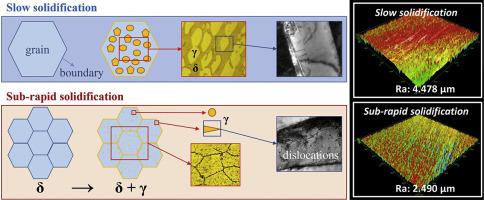当前位置:
X-MOL 学术
›
Mater. Charact.
›
论文详情
Our official English website, www.x-mol.net, welcomes your feedback! (Note: you will need to create a separate account there.)
Mechanism of δ → δ + γ phase transformation and hardening behavior of duplex stainless steel via sub-rapid solidification process
Materials Characterization ( IF 4.7 ) Pub Date : 2020-12-01 , DOI: 10.1016/j.matchar.2020.110679 Chenyang Zhu , Jie Zeng , Wanlin Wang , Shuai Chang , Cheng Lu
Materials Characterization ( IF 4.7 ) Pub Date : 2020-12-01 , DOI: 10.1016/j.matchar.2020.110679 Chenyang Zhu , Jie Zeng , Wanlin Wang , Shuai Chang , Cheng Lu

|
Abstract In this contribution, a duplex stainless steel (DSS) strip is obtained under the sub-rapid solidification condition by a recently developed fast dip tester, which is designed for simulation of the strip casting process. The mechanism of δ → δ + γ phase transformation and hardening behavior of DSS via the sub-rapid solidification process are investigated. The results suggest that the DSS under a rapid cooling rate would go through a shear/semi-shear phase transformation, which is different from the traditional diffusional transformation. There is no noticeable element precipitation content difference between the ferrite and austenite phases, and more dislocations are formed inside the austenite grains in the sub-rapid solidified sample. Furthermore, the austenite fraction of the sub-rapid solidified sample (4.08–4.32%) is substantially decreased compared with the slow solidified sample (36.12–39.37%). The length of grain/phase boundary, especially the dispersed small austenite particles is increased significantly. Besides, the hardness is increased to 311 HV and the wear-resisting property is enhanced with the wear consumption decreasing from 0.0291 to 0.0122 g, due to the multiple hardening effects under sub-rapid solidification process, including higher ferritic friction, grain refinement hardening, and dislocation hardening.
中文翻译:

双相不锈钢亚快速凝固过程δ→δ+γ相变机理及硬化行为
摘要 在此贡献中,使用最近开发的快速浸渍试验机在亚快速凝固条件下获得双相不锈钢 (DSS) 带材,该试验机专为模拟带材铸造过程而设计。研究了 δ → δ + γ 相变机制和 DSS 通过亚快速凝固过程的硬化行为。结果表明,在快速冷却速率下,DSS 会经历剪切/半剪切相变,这与传统的扩散相变不同。铁素体和奥氏体相之间没有明显的元素析出含量差异,在亚快速凝固样品中,在奥氏体晶粒内部形成了更多的位错。此外,亚快速凝固样品的奥氏体分数 (4.08-4. 32%) 与缓慢凝固的样品 (36.12–39.37%) 相比显着降低。晶界/相界的长度,特别是分散的小奥氏体颗粒显着增加。此外,由于亚快速凝固过程中的多重硬化效应,包括更高的铁素体摩擦、晶粒细化硬化、和位错硬化。
更新日期:2020-12-01
中文翻译:

双相不锈钢亚快速凝固过程δ→δ+γ相变机理及硬化行为
摘要 在此贡献中,使用最近开发的快速浸渍试验机在亚快速凝固条件下获得双相不锈钢 (DSS) 带材,该试验机专为模拟带材铸造过程而设计。研究了 δ → δ + γ 相变机制和 DSS 通过亚快速凝固过程的硬化行为。结果表明,在快速冷却速率下,DSS 会经历剪切/半剪切相变,这与传统的扩散相变不同。铁素体和奥氏体相之间没有明显的元素析出含量差异,在亚快速凝固样品中,在奥氏体晶粒内部形成了更多的位错。此外,亚快速凝固样品的奥氏体分数 (4.08-4. 32%) 与缓慢凝固的样品 (36.12–39.37%) 相比显着降低。晶界/相界的长度,特别是分散的小奥氏体颗粒显着增加。此外,由于亚快速凝固过程中的多重硬化效应,包括更高的铁素体摩擦、晶粒细化硬化、和位错硬化。



























 京公网安备 11010802027423号
京公网安备 11010802027423号